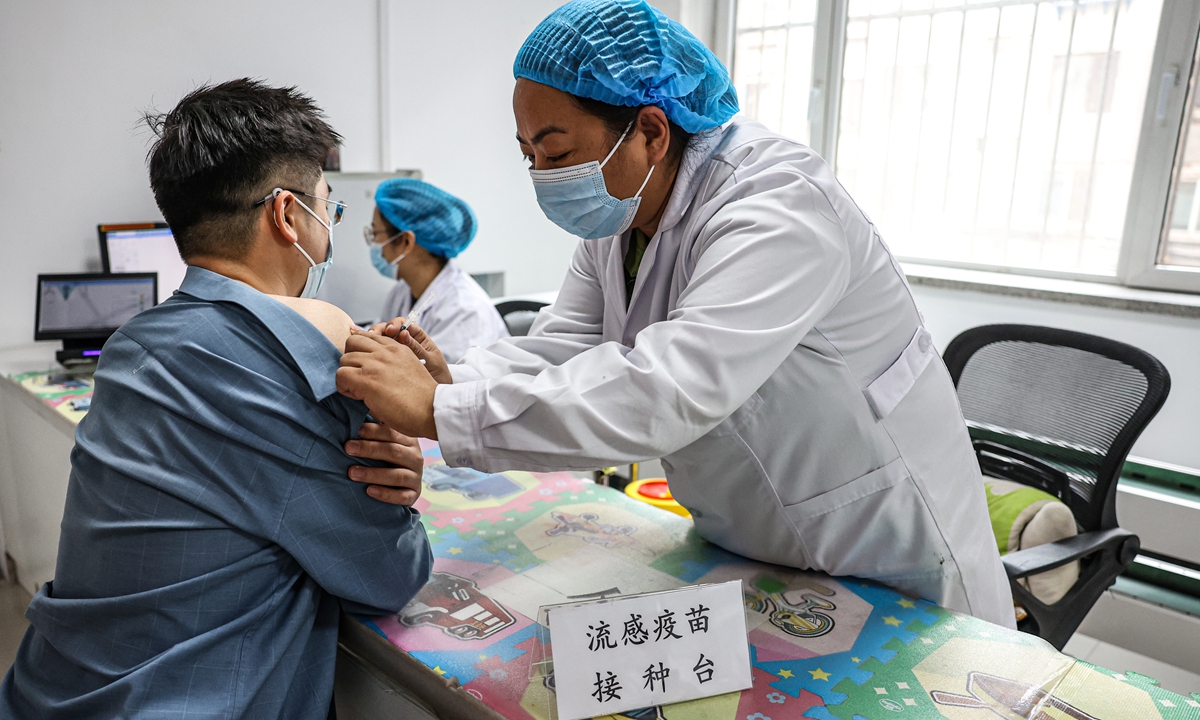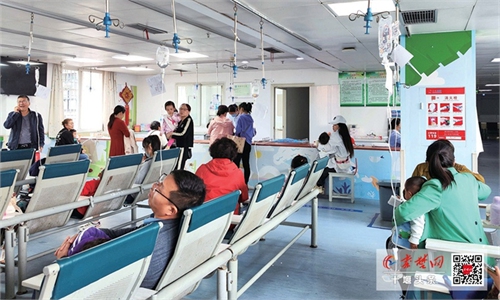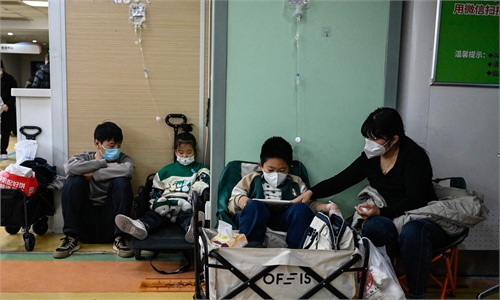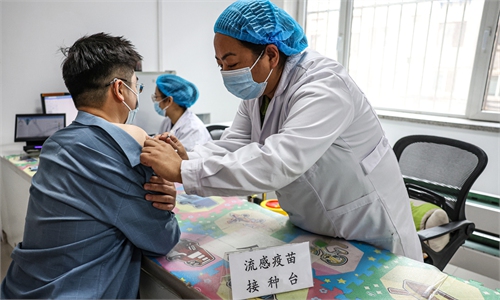Flu peak may last another one or two weeks, physician predicts as acute respiratory infections continue to rise in China

A resident receives a flu vaccine at a community health service center in Shenyang, Northeast China's Liaoning Province, on November 15, 2023. Respiratory diseases have progressed to their peak period of incidence across China, posing a threat to vulnerable groups such as children and the elderly. Photo: VCG
In the first winter of the post-pandemic era, the cases of acute respiratory diseases, including influenza, rhinovirus and mycoplasma pneumonia, continue to rise across China with the superposition of multiple respiratory diseases, according to the national health authority on Sunday.
Experts say one of the key reasons behind the prevalence of respiratory diseases this winter, which seems more noticeable than previous years, is due to the rise of an "immunity gap" resulting from a decrease in antibodies against these pathogens among the general public. They called on the public to get flu vaccines in a timely manner to reduce the risk of infection.
According to a press conference held by the National Health Commission on Sunday, the cases of recent respiratory diseases are mainly influenza, in addition to mycoplasma pneumonia, infections of rhinovirus, respiratory syncytial virus, adenovirus and others.
Multi-source monitoring shows that the main pathogens prevalent in respiratory infectious diseases among different age groups vary, Wang Huaqing, chief expert of an immunization program run by the China Center for Disease Control and Prevention, said at a press conference.
Influenza is a major respiratory disease in people of all ages. Additionally, rhinovirus infection is also predominant in people age 0-4, mycoplasma pneumonia and adenovirus infections are also predominant in people age 5-14, rhinovirus infection and COVID-19 are predominant in people age 15-59, while human metapneumovirus and common coronavirus infections are predominant in people age 60 and above, according to Wang.
For example, Taizhou in East China's Zhejiang Province, a city equipped with several national and provincial multi-respiratory and multi-pathogen surveillance stations, revealed on Friday that the positive rate of influenza virus in outpatient cases in the city increased to 50 percent. Since the beginning of November, the number of cases of mycoplasma pneumonia infection has accounted for about one fourth of cases with respiratory symptoms. Meanwhile, the spread of the XBB variant strain of COVID-19 continues to lessen and is currently at an extremely low level.
The flu peak may last another one or two weeks, with children and young people the most affected groups as many of them have to gather together when going to school or work, Li Tongzeng, the chief physician of the infection department at Beijing You'an Hospital, told the Global Times on Sunday.
It is expected when New Year's Day comes, those groups will gain immunity after infections, Li said. But he worried that the elderly could be the main group for respiratory diseases during the upcoming New Year's Day holidays as family gatherings surge, thus possibly ushering in another peak for respiratory diseases.
The situation is different this year, as the after-effects of the COVID-19 pandemic are also affecting the spread of respiratory infections, medical experts pointed out.
They explained that over the past three years, people have done a better job of protecting against respiratory diseases, with fewer social contacts, frequent school and work suspensions, which, during that period, led to a decrease in the frequency of respiratory infections other than COVID-19.
This is prone to creating an "immunity gap" with the level of people's antibodies reducing, Li said.
He noted that many children born during the COVID-19 outbreak have had less exposure to those pathogens, making them more vulnerable. As a result, the infection rate of respiratory infectious diseases has increased significantly this year compared with the past three years, and even exceeded the level in 2019. Children, in particular, have seen a surge in visits to children's hospitals, while infection rates among adults are relatively low.
The national health authority on Sunday also stressed that it is important to do a good job in epidemic prevention and control in schools, kindergartens, nursing homes and other key places with dense populations, and reduce personnel flow and visits.
The authority also reminded people to keep the habit of wearing masks, ensuring more ventilation inside and frequently washing their hands.
Ying Xumin, a senior official of the Hangzhou Health Committee of East China's Zhejiang Province, said at the press briefing that relevant authorities and medical institutions should optimize outpatient services. The respiratory tract outpatient and fever outpatient services at medical institutions at all levels should open on a regular basis and try to maintain their night outpatient care, and should not be arbitrarily suspended.
Ying called for real-time monitoring of outpatient and emergency department visits, waiting time of clinic services and other data in medical institutions. If any medical institutions are overloaded, relevant authorities should launch emergency adjustment mechanisms.
The local official also suggested that service processes should be simplified and unnecessary processes should be reduced. At the same time, auxiliary medical staff should be increased to maintain medical order and improve diagnosis and treatment efficiency.




